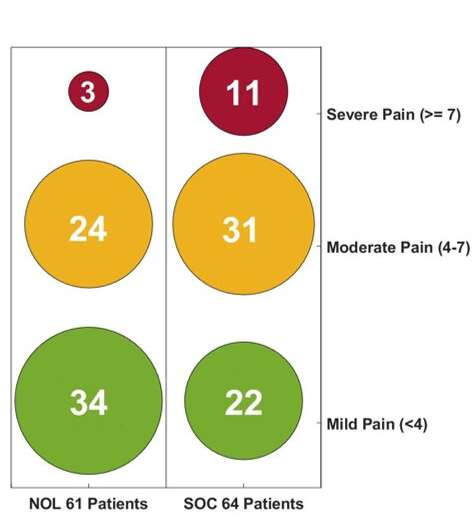More patients in the NOL guided group reported 'mild pain' and less reported severe pain in both studies. Credit: Medasense Biometrics Ltd
The odds of experiencing severe pain in the post-anesthesia care unit (PACU) is six times lower with Nociception Level (NOL) guided intraoperative analgesia compared to standard of care monitoring.
A new study, which pooled data from two randomized clinical trials, found that intraoperative opioid dosing based on the NOL index reduced the proportion of patients reporting severe pain by 70% and improved PACU pain scores by a median of 1.5 NRS points at 90 minutes post surgery. Additionally, NOL guidance was the only significant factor explaining the difference in the number of patients experiencing severe pain (OR 5.98, p=0.02).
"The study shows that how NOL monitoring can help minimize the prevalence of severe pain after surgery and all of its negative repercussions," says Prof. Albert Dahan, who led the study. "This represents an important benefit of nociception monitoring to patients and clinicians alike."
Medasense's NOL technology uses machine learning algorithms to continuously monitor patients during surgery, providing real-time information on nociception levels, personalizing dosing of analgesics to the patients' actual requirements. Earlier studies have shown that the NOL index outperforms other indexes for monitoring of pain response to surgical stimuli and that NOL-guided analgesia resulted in reduced intraoperative opioid consumption, leading to fewer intraoperative hypotensive events.
The new study, just published in Frontiers of Pain Research pooled data from two published trials with a similar protocol, analyzing data from 125 patients—61 of which received NOL-guided fentanyl dosing and 64 standard care. The patients were randomly divided so that one group received NOL-guided analgesia dosing during the surgery and the control group received analgesics according to standard of care (based on hemodynamic monitoring).
The study showed that while there was no difference in intraoperative fentanyl consumption between the groups, the patients in the NOL-guided group reported less pain in the first 90 minutes compared to the control arm.
"We are thrilled to see the results of this study and the positive impact our technology is having on patients," says Galit Zuckerman-Stark, CEO & Founder of Medasense, "Our goal is to improve the lives of patients by improving their pain management, and these findings demonstrate the potential of NOL to do just that."
More information: Imeen van der Wal et al, Intraoperative use of the machine learning-derived nociception level monitor results in less pain in the first 90 min after surgery, Frontiers in Pain Research (2023). DOI: 10.3389/fpain.2022.1086862
Provided by Medasense Biometrics























